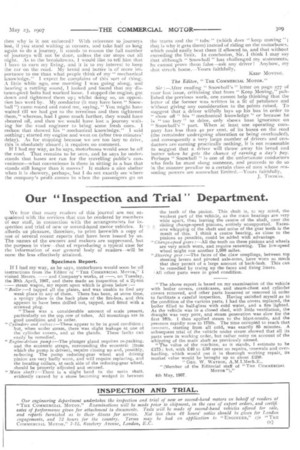Our "Inspection and Trial" Department.
Page 27

If you've noticed an error in this article please click here to report it so we can fix it.
We fear that many readers of this journal are not acquainted with the services that can be rendered by members of our staff, in connection with the arrangements for inspection and trial of new or second-hand motor vehicles. It affords us pleasure, therefore, to print herewith a copy of one of several recent reports that have been issued by us. The names of the owners and makers are suppressed, but the purpose in view—that of reproducing a typical case for the information of our general body of readers--will be none the less effectively attained.
Specimen Report.
If I had my way, as he says, motorbuses would soon be off instructions from the Editor of "THE COMMERCIAL MOTOR," I visited Messrs. -and Company's works, at —, on Tuesday, the 30th April, 1907, and there made an inspection of a 2i-ton -steam wagon, my report upon which is given below :— "Boiler :—I tapped all the plates, and was unable to find any
weak place in any of them. There has been, at some time, a spongy place in the back plate of the fire-box, and this appears to have been drilled out, tapped, and fitted with a screwed plug.
"There was a considerable amount of scale present, particularly on the top row of tubes. All mountings are in good condition and in order.
"Cylinders and valves :—These appear to be in good condition ; but, when under steam, there was slight leakage at one of the cylinder covers, and at the glands. These faults can easily be remedied.
"Engine-driven pump:—The plunger gland requires re-packing, and the eccentric straps, surrounding the eccentric (from which the pump is driven), require closing up and, possibly, re-boring The pum.p reducing-gear wheel and driving pinion are very badly worn, and will require replacing, and the locating collars, at each side of the reducing-gear wheel, should be properly adjusted and secured.
"Main shaft :—There is a slight bend in the main shaft, evidently caused by a stone becoming wedged in between
the teeth of the pinion. This shaft is, to my mind, the weakest part of the vehicle, as the main bearings are very wide apart, thus leaving the centre of the shaft, near the sliding change-speed pinions, entirely unsupported. Excessive whipping of the shaft and noise of the gear teeth is the result of this. I think a centre bearing, as close to the pinions as possible, could be added with advantage.
"Change-speed gears :—All the teeth on these pinions and wheels are very much worn, and require renewing. The low-speed wheel might run another 1,000 miles. "Steering gear :—The faces of the claw couplings, between top steering levers and pivoted axle-arms, have worn so much that they permit of a large amount of back-lash. This can be remedied by truing up the faces and fixing liners.
, All other parts were in good condition.
"The above report is based on my examination of the vehicle with boiler covers, crankcases, and steam-chest and cylinder covers removed, and other parts loosened or removed in order to facilitate a careful inspection. Having satisfied myself as to the condition of the various parts, I had the covers replaced, the boiler filled to half-glass with cold water, and a fire•lighted. As the vehicle was in a closed shed, with little ventilation, the draught was very poor, and steam generation was slow for the first 101b. I then applied steam to the blast-nozzle, and the pressure rapidly rose to 1751b. The time occupied to reach that mressure, starting from all cold, was exactly 85 minutes. A subsequent trial of the vehicle under steam showed that all its parts were in working order, but rather noisy on account of the whipping of the main shaft as previously named.
"The value of the machine, as it stands, I estimate to be £175; but, with £40 to £50 spent on repairs, renewals and overhauling, which would put it in thorough working repair, its market value would be brought up to about £250.
" GEO. W. WATSON, A.M.I.Mech.E.,
"(Member of the Editorial staff of "Tax COMMERCIAL MOTOR ")," 4th ?slay, 1907.






























